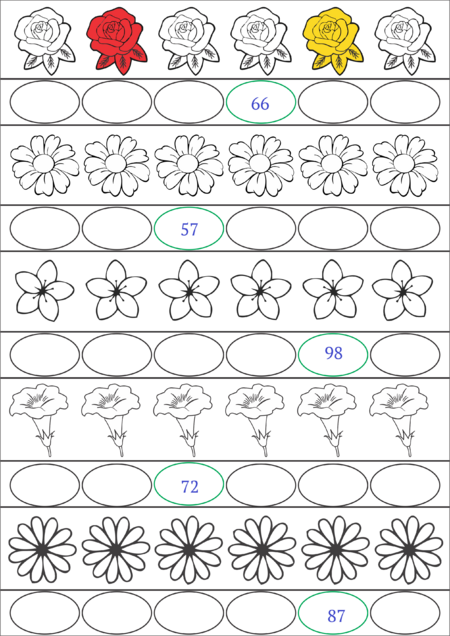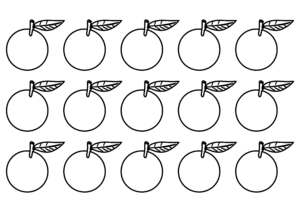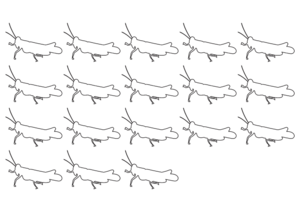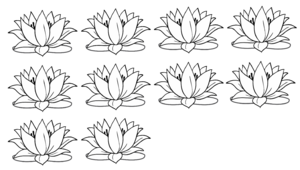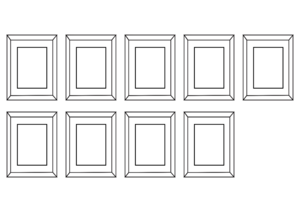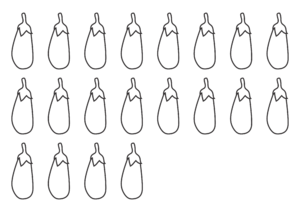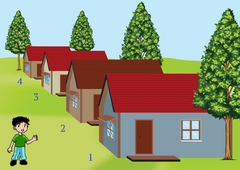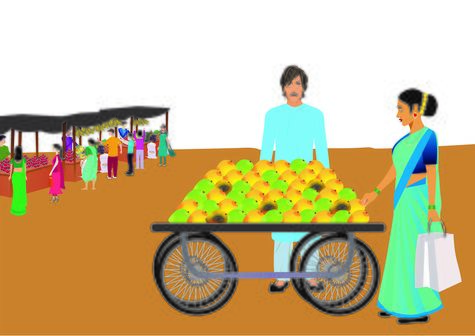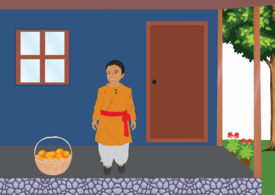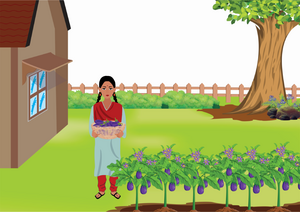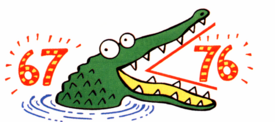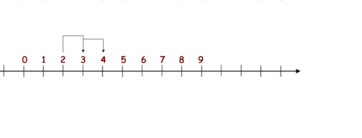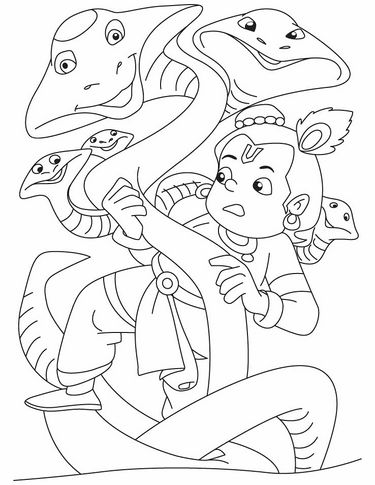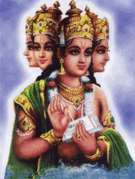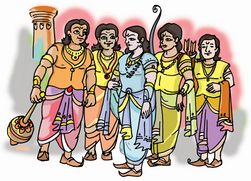Difference between revisions of "Number Knowledge"
(→Activity: My Train Ride: editing images) |
|||
| (63 intermediate revisions by the same user not shown) | |||
| Line 1: | Line 1: | ||
| − | |||
| − | |||
Welcome to Class 1 Number Knowledge lesson plan | Welcome to Class 1 Number Knowledge lesson plan | ||
| + | {{Infobox | ||
| + | | name = Ganita Education Series | ||
| + | | title = Class 1 Lesson Plans in English | ||
| + | | subheader = [[Introduction to Mathematics (English) | Lesson:1 Introduction to Mathematics]] | ||
| + | | subheader2 = [[Shapes | Lesson 2: Shapes]] | ||
| + | | subheader3 = [[Number Knowledge | Lesson 3: Number Knowledge]] | ||
| + | | subheader4 = [[Place value System | Lesson 4: Place value System]] | ||
| + | | subheader5 = [[Addition | Lesson 5: Addition]] | ||
| + | | subheader6 = [[Subtraction | Lesson 6: Subtraction]] | ||
| + | | subheader7 = [[Measurement | Lesson 7: Measurement]] | ||
| + | | subheader8 = [[Time | Lesson 8: Time ]] | ||
| + | | subheader9 = [[Whole and Parts | Lesson 9: Whole and Parts]] | ||
| + | | subheader10 = [[Money | Lesson 10: Money]]}} | ||
== Learning Objectives == | == Learning Objectives == | ||
| Line 70: | Line 81: | ||
|विंशतिः | |विंशतिः | ||
|} | |} | ||
| − | ==Practice Writing== | + | ==Practice Writing Numbers== |
| − | [[File:Number knowledge - | + | Writing exercise of Samskrit numbers. |
| + | {| class="wikitable" style="text-align:center;" | ||
| + | | style="height:80px; width: 100px;" |[[File:Number knowledge - Sanskrit Number 1.PNG|frameless]] | ||
| + | | style="height:80px; width: 100px;" |[[File:Number knowledge - Sanskrit Number 1.PNG|frameless]] | ||
| + | | style="height:80px; width: 100px;" | | ||
| + | | style="height:80px; width: 100px;" | | ||
| + | | style="height:80px; width: 100px;" | | ||
| + | | style="height:80px; width: 100px;" | | ||
| + | |- style="height:80px; width: 100px;" | ||
| + | | | ||
| + | | | ||
| + | | | ||
| + | | | ||
| + | | | ||
| + | | | ||
| + | |- style="height:80px; width: 100px;" | ||
| + | |[[File:Number knowledge - Sanskrit Number 2.PNG|frameless|66x66px]] | ||
| + | |[[File:Number knowledge - Sanskrit Number 2.PNG|frameless|66x66px]] | ||
| + | | | ||
| + | | | ||
| + | | | ||
| + | | | ||
| + | |- style="height:80px; width: 100px;" | ||
| + | | | ||
| + | | | ||
| + | | | ||
| + | | | ||
| + | | | ||
| + | | | ||
| + | |- style="height:80px; width: 100px;" | ||
| + | |[[File:Number knowledge - Sanskrit Number 3.PNG|frameless]] | ||
| + | |[[File:Number knowledge - Sanskrit Number 3.PNG|frameless]] | ||
| + | | | ||
| + | | | ||
| + | | | ||
| + | | | ||
| + | |- style="height:80px; width: 100px;" | ||
| + | | | ||
| + | | | ||
| + | | | ||
| + | | | ||
| + | | | ||
| + | | | ||
| + | |- style="height:80px; width: 100px;" | ||
| + | |[[File:Number knowledge - Sanskrit Number 4.PNG|frameless|58x58px]] | ||
| + | |[[File:Number knowledge - Sanskrit Number 4.PNG|frameless|58x58px]] | ||
| + | | | ||
| + | | | ||
| + | | | ||
| + | | | ||
| + | |- style="height:80px; width: 100px;" | ||
| + | | | ||
| + | | | ||
| + | | | ||
| + | | | ||
| + | | | ||
| + | | | ||
| + | |- style="height:80px; width: 100px;" | ||
| + | |[[File:Number knowledge - Sanskrit Number 5.PNG|frameless|68x68px]] | ||
| + | |[[File:Number knowledge - Sanskrit Number 5.PNG|frameless|68x68px]] | ||
| + | | | ||
| + | | | ||
| + | | | ||
| + | | | ||
| + | |} | ||
See the end of this chapter for more practice sheets. | See the end of this chapter for more practice sheets. | ||
| − | == Activity: Find the 10s == | + | == Expanded forms of Numbers == |
| + | Number Exercise: Partitioning a 2-digit number (20 to 99) An introduction to place-value system. | ||
| + | |||
| + | === Activity: Find the 10s === | ||
Number exercise: Partitioning a 2-digit number. | Number exercise: Partitioning a 2-digit number. | ||
Draw a line around 10 items and write the remaining numbers as shown in the example. | Draw a line around 10 items and write the remaining numbers as shown in the example. | ||
{| class="wikitable" | {| class="wikitable" | ||
| − | |15 = <u>10</u> and <u>5</u> | + | | style="height:50px; width:180px;" |15 = <u>10</u> and <u>5</u> |
| − | + | | style="height:50px; width:180px;" |18 = _____ and _____ | |
| − | |18 = _____ and _____ | ||
| − | |||
|- | |- | ||
| + | |[[File:Number knowledge - BANANA 15 CIRCLE 10.png|frameless|250x250px]] | ||
| + | |[[File:Number Knowledge - BRINJAL.png|frameless|250x250px]] | ||
| + | |- style="height:50px; width:180px;" | ||
|19 = _______ and _______ | |19 = _______ and _______ | ||
| − | |||
|20 = _______ and _______ | |20 = _______ and _______ | ||
| − | |||
|- | |- | ||
| + | |[[File:Number knowledge - CORN.png|frameless|250x250px]] | ||
| + | |[[File:BHENDI.png|frameless|250x250px]] | ||
| + | |- style="height:50px; width:180px;" | ||
|13 = _______ and _______ | |13 = _______ and _______ | ||
| − | |||
|11 = _______ and _______ | |11 = _______ and _______ | ||
| − | |||
|- | |- | ||
| + | |[[File:Number knowledge - POTATO.png|frameless|250x250px]] | ||
| + | |[[File:Number Knowledge - Bottle gourd.png|frameless|250x250px]] | ||
| + | |- style="height:50px; width:180px;" | ||
|12 = _______ and _______ | |12 = _______ and _______ | ||
| − | |||
| − | |||
|14 = _______ and _______ | |14 = _______ and _______ | ||
| − | |||
| − | |||
| − | |||
| − | |||
| − | |||
| − | |||
| − | |||
| − | |||
| − | |||
| − | |||
| − | |||
|- | |- | ||
| − | |47 has ______ and ______ | + | |[[File:Number Knoweledge - LEMON.png|frameless|245x245px]] |
| − | |71 has ______ and ______ | + | |[[File:Number Knowledge - CARROT.png|frameless|250x250px]] |
| − | |40 has ______ and ______ | + | |}Write each number identifying the number of groups of 10s |
| + | {| class="wikitable" | ||
| + | | style="height:50px; width:180px;" |34 has <u>30</u> and <u>4</u> | ||
| + | | style="height:50px; width:180px;" |78 has <u>70</u> and <u>8</u> | ||
| + | | style="height:50px; width:180px;" |91 has ______ and ______ | ||
| + | |- | ||
| + | | style="height:50px; width:180px;" |47 has ______ and ______ | ||
| + | | style="height:50px; width:180px;" |71 has ______ and ______ | ||
| + | | style="height:50px; width:180px;" |40 has ______ and ______ | ||
|- | |- | ||
| − | |63 has ______ and ______ | + | | style="height:50px; width:180px;" |63 has ______ and ______ |
| − | |98 has ______ and ______ | + | | style="height:50px; width:180px;" |98 has ______ and ______ |
| − | |39 has ______ and ______ | + | | style="height:50px; width:180px;" |39 has ______ and ______ |
|- | |- | ||
| − | |76 has ______ and ______ | + | | style="height:50px; width:180px;" |76 has ______ and ______ |
| − | |81 has ______ and ______ | + | | style="height:50px; width:180px;" |81 has ______ and ______ |
| − | |53 has ______ and ______ | + | | style="height:50px; width:180px;" |53 has ______ and ______ |
|- | |- | ||
| − | |33 has ______ and ______ | + | | style="height:50px; width:180px;" |33 has ______ and ______ |
| − | |41 has ______ and ______ | + | | style="height:50px; width:180px;" |41 has ______ and ______ |
| − | |59 has ______ and ______ | + | | style="height:50px; width:180px;" |59 has ______ and ______ |
|- | |- | ||
| − | | colspan="3" |Write the missing number | + | | colspan="3" style="height:50px; width:180px;" |Write the missing number |
|- | |- | ||
| − | |99 has <u>90</u> and <u>9</u> | + | | style="height:50px; width:180px;" |99 has <u>90</u> and <u>9</u> |
| − | |36 has <u>30</u> and <u>6</u> | + | | style="height:50px; width:180px;" |36 has <u>30</u> and <u>6</u> |
| − | |85 has ______ and 5 | + | | style="height:50px; width:180px;" |85 has ______ and 5 |
|- | |- | ||
| − | |66 has 60 and ______ | + | | style="height:50px; width:180px;" |66 has 60 and ______ |
| − | |______ has 20 and 8 | + | | style="height:50px; width:180px;" |______ has 20 and 8 |
| − | |43 has ______ and 3 | + | | style="height:50px; width:180px;" |43 has ______ and 3 |
|- | |- | ||
| − | |______ has 20 and 4 | + | | style="height:50px; width:180px;" |______ has 20 and 4 |
| − | |67 has 60 and ______ | + | | style="height:50px; width:180px;" |67 has 60 and ______ |
| − | |______ has 80 and 8 | + | | style="height:50px; width:180px;" |______ has 80 and 8 |
|} | |} | ||
| − | == Activity: Identifying and writing expanded forms == | + | === Activity: Identifying and writing expanded forms === |
Number Exercise: Writing expanded forms (75 to 120) | Number Exercise: Writing expanded forms (75 to 120) | ||
{| class="wikitable" | {| class="wikitable" | ||
| Line 151: | Line 227: | ||
How many stacks and blocks are needed for the following numbers. Find the missing spots. | How many stacks and blocks are needed for the following numbers. Find the missing spots. | ||
| − | |- | + | |- style="text-align:center" |
| − | |76 | + | | style="height:50px; width:30px;" |76 |
| − | |Seventy - six | + | | style="height:50px; width:80px;" |Seventy - six |
| − | |<u>Seven</u> Stacks and <u>Six</u> Blocks | + | | style="height:50px; width:120px;" |<u>Seven</u> Stacks and <u>Six</u> Blocks |
| − | |- | + | |- style="text-align:center" |
| − | |119 | + | | style="height:50px; width:30px;" |119 |
| − | | | + | | style="height:50px; width:80px;" | |
| − | |<u>Ten</u> Stacks and <u>Nineteen</u> Blocks | + | | style="height:50px; width:120px;" |<u>Ten</u> Stacks and <u>Nineteen</u> Blocks |
| − | |- | + | |- style="text-align:center" |
| − | | | + | | style="height:50px; width:30px;" | |
| − | |Ninety - five | + | | style="height:50px; width:80px;" |Ninety - five |
| − | |________ Stacks and ________ Blocks | + | | style="height:50px; width:120px;" |________ Stacks and ________ Blocks |
| − | |- | + | |- style="text-align:center" |
| − | |110 | + | | style="height:50px; width:30px;" |110 |
| − | |One hundred ten | + | | style="height:50px; width:80px;" |One hundred ten |
| − | |________ Stacks and ________ Blocks | + | | style="height:50px; width:120px;" |________ Stacks and ________ Blocks |
| − | |- | + | |- style="text-align:center" |
| − | |107 | + | | style="height:50px; width:30px;" |107 |
| − | | | + | | style="height:50px; width:80px;" | |
| − | |________ Stacks and ________ Blocks | + | | style="height:50px; width:120px;" |________ Stacks and ________ Blocks |
| − | |- | + | |- style="text-align:center" |
| − | |120 | + | | style="height:50px; width:30px;" |120 |
| − | | | + | | style="height:50px; width:80px;" | |
| − | |________ Stacks and ________ Blocks | + | | style="height:50px; width:120px;" |________ Stacks and ________ Blocks |
| − | |- | + | |- style="text-align:center" |
| − | | | + | | style="height:50px; width:30px;" | |
| − | |One hundred fourteen | + | | style="height:50px; width:80px;" |One hundred fourteen |
| − | |________ Stacks and <u>4</u> Blocks | + | | style="height:50px; width:120px;" |________ Stacks and <u>4</u> Blocks |
| − | |- | + | |- style="text-align:center" |
| − | |87 | + | | style="height:50px; width:30px;" |87 |
| − | | | + | | style="height:50px; width:80px;" | |
| − | |8 Stacks and ________ Blocks | + | | style="height:50px; width:120px;" |8 Stacks and ________ Blocks |
| − | |- | + | |- style="text-align:center" |
| − | |102 | + | | style="height:50px; width:30px;" |102 |
| − | | | + | | style="height:50px; width:80px;" | |
| − | |________ Stacks and ________ Blocks | + | | style="height:50px; width:120px;" |________ Stacks and ________ Blocks |
| − | |- | + | |- style="text-align:center" |
| − | |90 | + | | style="height:50px; width:30px;" |90 |
| − | | | + | | style="height:50px; width:80px;" | |
| − | |________ Stacks and ________ Blocks | + | | style="height:50px; width:120px;" |________ Stacks and ________ Blocks |
|} | |} | ||
| Line 196: | Line 272: | ||
Number Exercise: Count forward and backward 50 to 99 (by 1s, 2s, and 3s). | Number Exercise: Count forward and backward 50 to 99 (by 1s, 2s, and 3s). | ||
| − | Count forward by 1 and colour that flower yellow. Count backward by 2 and colour that flower red. Write all the numbers in the | + | Count forward by 1 and colour that flower yellow. Count backward by 2 and colour that flower red. Write all the numbers in the circles given below. |
| − | |||
| − | |||
| − | |||
| − | |||
| − | [[File:Number knowledge - | + | [[File:Number knowledge - Lotus flowers and circles with numbers.png|frameless|636x636px]] |
Count by 5 and colour that box red. Count by 10 and colour that box yellow. | Count by 5 and colour that box red. Count by 10 and colour that box yellow. | ||
| − | {| class="wikitable" style="text-align:center;" | + | {| class="wikitable" style="margin-left: 100px; margin-right:auto; text-align:center;" |
| − | | style="height: | + | | style="height:35px; width:35px; background-color:#ff6347;" |5 |
| − | | style="height: | + | | style="height:35px; width:35px; background-color:#fafad2;" |10 |
| − | | style="height: | + | | style="height:35px; width:35px; background-color:#ff6347;" |15 |
| − | | style="height: | + | | style="height:35px; width:35px; background-color:#fafad2;" |20 |
| − | | style="height: | + | | style="height:35px; width:35px; background-color:#ff6347;" |25 |
| − | | style="height: | + | | style="height:35px; width:35px;" |30 |
| − | | style="height: | + | | style="height:35px; width:35px;" |35 |
| − | | style="height: | + | | style="height:35px; width:35px;" |40 |
| − | | style="height: | + | | style="height:35px; width:35px;" |45 |
| − | | style="height: | + | | style="height:35px; width:35px;" |50 |
|- | |- | ||
| − | | style="height: | + | | style="height:35px; width:35px;" |23 |
| − | | style="height: | + | | style="height:35px; width:35px;" |28 |
| − | | style="height: | + | | style="height:35px; width:35px;" |33 |
| − | | style="height: | + | | style="height:35px; width:35px;" |38 |
| − | | style="height: | + | | style="height:35px; width:35px;" |43 |
| − | | style="height: | + | | style="height:35px; width:35px;" |48 |
| − | | style="height: | + | | style="height:35px; width:35px;" |53 |
| − | | style="height: | + | | style="height:35px; width:35px;" |58 |
| − | | style="height: | + | | style="height:35px; width:35px;" |63 |
| − | | style="height: | + | | style="height:35px; width:35px;" |68 |
|- | |- | ||
| − | | style="height: | + | | style="height:35px; width:35px;" |36 |
| − | | style="height: | + | | style="height:35px; width:35px;" |41 |
| − | | style="height: | + | | style="height:35px; width:35px;" |46 |
| − | | style="height: | + | | style="height:35px; width:35px;" |51 |
| − | | style="height: | + | | style="height:35px; width:35px;" |56 |
| − | | style="height: | + | | style="height:35px; width:35px;" |61 |
| − | | style="height: | + | | style="height:35px; width:35px;" |66 |
| − | | style="height: | + | | style="height:35px; width:35px;" |71 |
| − | | style="height: | + | | style="height:35px; width:35px;" |76 |
| − | | style="height: | + | | style="height:35px; width:35px;" |81 |
|- | |- | ||
| − | | style="height: | + | | style="height:35px; width:35px;" |17 |
| − | | style="height: | + | | style="height:35px; width:35px;" |22 |
| − | | style="height: | + | | style="height:35px; width:35px;" |27 |
| − | | style="height: | + | | style="height:35px; width:35px;" |32 |
| − | | style="height: | + | | style="height:35px; width:35px;" |37 |
| − | | style="height: | + | | style="height:35px; width:35px;" |42 |
| − | | style="height: | + | | style="height:35px; width:35px;" |47 |
| − | | style="height: | + | | style="height:35px; width:35px;" |52 |
| − | | style="height: | + | | style="height:35px; width:35px;" |57 |
| − | | style="height: | + | | style="height:35px; width:35px;" |62 |
|} | |} | ||
| + | Count by 3 and circle the numbers starting from 1. Join the circled numbers. Colour the picture yellow. | ||
| + | |||
| + | [[File:Number knowledge - Sunflower connect the dots (E).png|frameless|704x704px]] | ||
== Activity: How many of a Total == | == Activity: How many of a Total == | ||
| Line 289: | Line 364: | ||
== Cardinal and Ordinal Numbers == | == Cardinal and Ordinal Numbers == | ||
| − | [[File:Number knowledge - Four houses away.png|right|frameless| | + | A cardinal number defines how many (number) of something are present. Example, my friend's house is 4 (four) houses away from my house. [[File:Number knowledge - Bank (E).png|left|frameless|278x278px]][[File:Number knowledge - Four houses away.png|right|frameless|240x240px]]An ordinal number defines where (position) is something located in a list. Example, my friend’s house is the '''fourth''' building from my house'''.''' |
| − | |||
| − | |||
| − | |||
| − | |||
So, if we say there are '''five''' persons standing in the line in a bank and the '''fifth''' person is wearing a blue shirt, we are | So, if we say there are '''five''' persons standing in the line in a bank and the '''fifth''' person is wearing a blue shirt, we are | ||
* counting the number of persons, seen standing in a line | * counting the number of persons, seen standing in a line | ||
* identifying the position of a particular person | * identifying the position of a particular person | ||
| − | == Activity: My Train Ride == | + | === Activity: My Train Ride === |
| − | [[File:Number knowledge - Train.jpg|frameless|left|401x401px]] | + | Number Exercise: Using the cardinal word forms and Ordinal numbers.[[File:Number knowledge - Train.jpg|frameless|left|401x401px]] |
During the summer holidays, I went to Manguluru from Bengaluru by a train. The engine is the ___________ (1) and the foremost carriage of the train. My mother told me that a train also has cars in which we all travelled. The engine of our train was very strong. It pulled our long train having _________(18) cars easily even in uphill places. Our car was in the middle, _________ (9) from the engine. I sat by the window and was counting the trains and the number of cars they had. The ______(3) train that sped by us was very long having _________ (22) cars. I was surprised to see that the _________ (6) car of a train standing in a station had the words “Medical Van” written on it. It started to move when the guard waved a green flag standing on the _______ (7) car which was also the train’s last car. | During the summer holidays, I went to Manguluru from Bengaluru by a train. The engine is the ___________ (1) and the foremost carriage of the train. My mother told me that a train also has cars in which we all travelled. The engine of our train was very strong. It pulled our long train having _________(18) cars easily even in uphill places. Our car was in the middle, _________ (9) from the engine. I sat by the window and was counting the trains and the number of cars they had. The ______(3) train that sped by us was very long having _________ (22) cars. I was surprised to see that the _________ (6) car of a train standing in a station had the words “Medical Van” written on it. It started to move when the guard waved a green flag standing on the _______ (7) car which was also the train’s last car. | ||
It was fun walking along with my father in a moving train crossing __________ (5) cars to reach the __________ (4) car. It was the food or the pantry car. As the train took a bend in the hills, I saw that the ladies’ car was just _________ (2) cars away from the engine. Our car was followed by three air-conditioned cars which were in __________ (10), ___________ (11) and ____________ (12) places away from the engine. When I got off the train at Manguluru, as I walked towards the station, I saw the railway porters unloading many things from two cars in the rear. They were the ___________ (16) and _________ (17) cars. It was a joyous train ride and I was looking forward to visit my grandparents. | It was fun walking along with my father in a moving train crossing __________ (5) cars to reach the __________ (4) car. It was the food or the pantry car. As the train took a bend in the hills, I saw that the ladies’ car was just _________ (2) cars away from the engine. Our car was followed by three air-conditioned cars which were in __________ (10), ___________ (11) and ____________ (12) places away from the engine. When I got off the train at Manguluru, as I walked towards the station, I saw the railway porters unloading many things from two cars in the rear. They were the ___________ (16) and _________ (17) cars. It was a joyous train ride and I was looking forward to visit my grandparents. | ||
| + | |||
| + | === Activity: Pick a sweet mango === | ||
| + | Number Exercise – Sorting, Ordinal numbers till 50, Making a number chart | ||
| + | [[File:Number knowledge - Market Scene.jpg|center|frameless|475x475px]] | ||
| + | Lakshmi likes sweet mangoes. So, her mother went to the wholesale market to buy mangoes for her to distribute to her friends on her birthday. She knew that ripe mangoes are yellow in color and they are sweet. Lakshmi’s mother wanted to make some mango pickle so she chose unripe mangoes from the carts. From the top row tell the number and position of the ripe and unripe mangoes. | ||
| + | {| class="wikitable" | ||
| + | ! colspan="2" |Ripe Mangoes | ||
| + | ! colspan="2" |Unripe mangoes | ||
| + | |- | ||
| + | | style="height:30px; width:75px; text-align:left;" |Cardinal | ||
| + | | style="height:30px; width:300px; text-align:left;" |Ordinal | ||
| + | | style="height:30px; width:75px; text-align:left;" |Cardinal | ||
| + | | style="height:30px; width:300px; text-align:left;" |Ordinal | ||
| + | |- | ||
| + | | style="height:30px; width:75px;" | | ||
| + | | style="height:30px; width:300px;" | | ||
| + | | style="height:30px; width:75px;" | | ||
| + | | style="height:30px; width:300px;" | | ||
| + | |- | ||
| + | | style="height:30px; width:75px;" | | ||
| + | | style="height:30px; width:300px;" | | ||
| + | | style="height:30px; width:75px;" | | ||
| + | | style="height:30px; width:300px;" | | ||
| + | |- | ||
| + | | style="height:30px; width:75px;" | | ||
| + | | style="height:30px; width:300px;" | | ||
| + | | style="height:30px; width:75px;" | | ||
| + | | style="height:30px; width:300px;" | | ||
| + | |- | ||
| + | | style="height:30px; width:75px;" | | ||
| + | | style="height:30px; width:300px;" | | ||
| + | | style="height:30px; width:75px;" | | ||
| + | | style="height:30px; width:300px;" | | ||
| + | |- | ||
| + | | style="height:30px; width:75px;" | | ||
| + | | style="height:30px; width:300px;" | | ||
| + | | style="height:30px; width:75px;" | | ||
| + | | style="height:30px; width:300px;" | | ||
| + | |- | ||
| + | | style="height:30px; width:75px;" | | ||
| + | | style="height:30px; width:300px;" | | ||
| + | | style="height:30px; width:75px;" | | ||
| + | | style="height:30px; width:300px;" | | ||
| + | |- | ||
| + | | style="height:30px; width:75px;" | | ||
| + | | style="height:30px; width:300px;" | | ||
| + | | style="height:30px; width:75px;" | | ||
| + | | style="height:30px; width:300px;" | | ||
| + | |- | ||
| + | | style="height:30px; width:75px;" | | ||
| + | | style="height:30px; width:300px;" | | ||
| + | | style="height:30px; width:75px;" | | ||
| + | | style="height:30px; width:300px;" | | ||
| + | |- | ||
| + | | style="height:30px; width:75px;" | | ||
| + | | style="height:30px; width:300px;" | | ||
| + | | style="height:30px; width:75px;" | | ||
| + | | style="height:30px; width:300px;" | | ||
| + | |- | ||
| + | | style="height:30px; width:75px;" | | ||
| + | | style="height:30px; width:300px;" | | ||
| + | | style="height:30px; width:75px;" | | ||
| + | | style="height:30px; width:300px;" | | ||
| + | |- | ||
| + | | style="height:30px; width:75px;" | | ||
| + | | style="height:30px; width:300px;" | | ||
| + | | style="height:30px; width:75px;" | | ||
| + | | style="height:30px; width:300px;" | | ||
| + | |- | ||
| + | | style="height:30px; width:75px;" | | ||
| + | | style="height:30px; width:300px;" | | ||
| + | | style="height:30px; width:75px;" | | ||
| + | | style="height:30px; width:300px;" | | ||
| + | |- | ||
| + | | style="height:30px; width:75px;" | | ||
| + | | style="height:30px; width:300px;" | | ||
| + | | style="height:30px; width:75px;" | | ||
| + | | style="height:30px; width:300px;" | | ||
| + | |- | ||
| + | | style="height:30px; width:75px;" | | ||
| + | | style="height:30px; width:300px;" | | ||
| + | | style="height:30px; width:75px;" | | ||
| + | | style="height:30px; width:300px;" | | ||
| + | |- | ||
| + | | style="height:30px; width:75px;" | | ||
| + | | style="height:30px; width:300px;" | | ||
| + | | style="height:30px; width:75px;" | | ||
| + | | style="height:30px; width:300px;" | | ||
| + | |- | ||
| + | | style="height:30px; width:75px;" | | ||
| + | | style="height:30px; width:300px;" | | ||
| + | | style="height:30px; width:75px;" | | ||
| + | | style="height:30px; width:300px;" | | ||
| + | |- | ||
| + | | style="height:30px; width:75px;" | | ||
| + | | style="height:30px; width:300px;" | | ||
| + | | style="height:30px; width:75px;" | | ||
| + | | style="height:30px; width:300px;" | | ||
| + | |- | ||
| + | | style="height:30px; width:75px;" | | ||
| + | | style="height:30px; width:300px;" | | ||
| + | | style="height:30px; width:75px;" | | ||
| + | | style="height:30px; width:300px;" | | ||
| + | |- | ||
| + | | style="height:30px; width:75px;" | | ||
| + | | style="height:30px; width:300px;" | | ||
| + | | style="height:30px; width:75px;" | | ||
| + | | style="height:30px; width:300px;" | | ||
| + | |- | ||
| + | | style="height:30px; width:75px;" | | ||
| + | | style="height:30px; width:300px;" | | ||
| + | | style="height:30px; width:75px;" | | ||
| + | | style="height:30px; width:300px;" | | ||
| + | |- | ||
| + | |} | ||
| + | |||
| + | == Odd and Even Numbers == | ||
| + | [[File:Number knowledge - Rama with basket of oranges.png|right|frameless|275x275px]] | ||
| + | Let’s talk about sharing now. Rama visited an orange farm when he went to his grandparents’ home. He brought 15 oranges home. And he wondered what he would do with so many oranges… | ||
| + | |||
| + | So, he decided to share them with his friends. He wanted to give the same number of oranges to both his friends. | ||
| + | |||
| + | Don’t we all share with whom we care for. | ||
| + | |||
| + | [[File:Number knowledge - orange.png|frameless|45x45px]][[File:Number knowledge - orange.png|frameless|45x45px]][[File:Number knowledge - orange.png|frameless|45x45px]][[File:Number knowledge - orange.png|frameless|45x45px]][[File:Number knowledge - orange.png|frameless|45x45px]][[File:Number knowledge - orange.png|frameless|45x45px]][[File:Number knowledge - orange.png|frameless|45x45px]][[File:Number knowledge - orange.png|frameless|45x45px]][[File:Number knowledge - orange.png|frameless|45x45px]][[File:Number knowledge - orange.png|frameless|45x45px]][[File:Number knowledge - orange.png|frameless|45x45px]][[File:Number knowledge - orange.png|frameless|45x45px]][[File:Number knowledge - orange.png|frameless|45x45px]][[File:Number knowledge - orange.png|frameless|45x45px]][[File:Number knowledge - orange.png|frameless|45x45px]] | ||
| + | |||
| + | If Rama equally shared the oranges he had into two baskets... | ||
| + | {| class="wikitable" | ||
| + | |[[File:Number knowledge - Basket of oranges.png|frameless|159x159px]] | ||
| + | |[[File:Number knowledge - Basket of oranges.png|frameless|159x159px]] | ||
| + | |- | ||
| + | |Count and write how many oranges are in the basket _________. | ||
| + | |Count and write how many oranges are in the basket _________. | ||
| + | |} | ||
| + | Rama split _____________ out of 15 oranges into two baskets of each and had __________ remaining with him which could not be shared with both his friends. He wondered why he could not share 15 oranges completely. However, he happily shared the rest and ate the one orange himself. | ||
| + | |||
| + | Then he gave the two baskets to his friends and asked his teacher about his activity. The teacher called all the class students. He asked each student what things they had more in number that could be shared with others. | ||
| + | [[File:Number knowledge - Latha with brinjals.png|right|frameless]] | ||
| + | Latha replied that they grew vegetables in their backyard and had grown many brinjal plants. | ||
| + | |||
| + | [[File:Number knowledge - Brinjal.png|frameless|35x35px]] [[File:Number knowledge - Brinjal.png|frameless|35x35px]] [[File:Number knowledge - Brinjal.png|frameless|35x35px]] [[File:Number knowledge - Brinjal.png|frameless|35x35px]] [[File:Number knowledge - Brinjal.png|frameless|35x35px]] [[File:Number knowledge - Brinjal.png|frameless|35x35px]] [[File:Number knowledge - Brinjal.png|frameless|35x35px]] [[File:Number knowledge - Brinjal.png|frameless|35x35px]] [[File:Number knowledge - Brinjal.png|frameless|35x35px]] [[File:Number knowledge - Brinjal.png|frameless|35x35px]] [[File:Number knowledge - Brinjal.png|frameless|35x35px]] [[File:Number knowledge - Brinjal.png|frameless|35x35px]] [[File:Number knowledge - Brinjal.png|frameless|35x35px]] [[File:Number knowledge - Brinjal.png|frameless|35x35px]] [[File:Number knowledge - Brinjal.png|frameless|35x35px]] [[File:Number knowledge - Brinjal.png|frameless|35x35px]] [[File:Number knowledge - Brinjal.png|frameless|35x35px]] [[File:Number knowledge - Brinjal.png|frameless|35x35px]] | ||
| + | |||
| + | She had _______________ brinjals. The teacher then asked her to place one brinjal each into two heaps. She placed the brinjals in the following manner. | ||
| + | {| class="wikitable" | ||
| + | |[[File:Number knowledge - Brinjal.png|frameless|35x35px]] [[File:Number knowledge - Brinjal.png|frameless|35x35px]] [[File:Number knowledge - Brinjal.png|frameless|35x35px]] [[File:Number knowledge - Brinjal.png|frameless|35x35px]] [[File:Number knowledge - Brinjal.png|frameless|35x35px]] [[File:Number knowledge - Brinjal.png|frameless|35x35px]] | ||
| + | |[[File:Number knowledge - Brinjal.png|frameless|35x35px]] [[File:Number knowledge - Brinjal.png|frameless|35x35px]] [[File:Number knowledge - Brinjal.png|frameless|35x35px]] [[File:Number knowledge - Brinjal.png|frameless|35x35px]] [[File:Number knowledge - Brinjal.png|frameless|35x35px]] [[File:Number knowledge - Brinjal.png|frameless|35x35px]] | ||
| + | |- | ||
| + | |[[File:Number knowledge - Brinjal.png|frameless|35x35px]] [[File:Number knowledge - Brinjal.png|frameless|35x35px]] [[File:Number knowledge - Brinjal.png|frameless|35x35px]] | ||
| + | |[[File:Number knowledge - Brinjal.png|frameless|35x35px]] [[File:Number knowledge - Brinjal.png|frameless|35x35px]] [[File:Number knowledge - Brinjal.png|frameless|35x35px]] | ||
| + | |- | ||
| + | |Count and write how many brinjals are present _________. | ||
| + | |Count and write how many brinjals are present _________. | ||
| + | |} | ||
| + | She did not have anything left after making two equal groups of brinjals. | ||
| + | |||
| + | The teacher informed that, any | ||
| + | '''Number ending in 0 2 4 6 8 are called Even''' | ||
| + | |||
| + | '''Number ending in 1 3 5 7 9 are called Odd''' | ||
| + | Rama had 15 oranges, having _________ as an ending number. So, 15 is an ___________ number. After splitting them in to two baskets he had ________ remaining. Rama understood that he had an odd number of oranges. | ||
| + | |||
| + | Latha had 18 oranges having __________ as an ending number. So, 18 is an ___________ number. After splitting them in to two heaps she had _____ with her. Latha came to know that she had an even number of brinjals. Latha gave one heap of brinjals to her neighbour and took one home happily. | ||
| + | '''Any number that can be split into two equal quantities without any leftover is Even.''' | ||
| + | |||
| + | '''Any number that leaves behind something after being split into two sets of equal quantities is Odd.''' | ||
| + | |||
| + | === Activity: Identifying even and odd numbers === | ||
| + | Number Exercise – Visual identification of odd and even numbers (0 to 50) | ||
| + | |||
| + | Identify looking at the number and write if it is even or odd, strike out as you write. Place only even numbers in one box and odd into another box. | ||
| + | {| class="wikitable" | ||
| + | | rowspan="2" style="height:125px; width:150px;" | <big><s>25</s> <s>18</s> 9 23 6 28 34 10 39 11 41 30 15 21 1 29 7 32 43 19 24 17 35 12 46 3 20 13 16 37 49 31 26 8 36 2 14 22</big> | ||
| + | | style="height:150px; width:400px; text-align:left; vertical-align:top;" | Write Even Numbers | ||
| + | |||
| + | '''18''' | ||
| + | |- | ||
| + | | style="height:150px; width:400px; text-align:left; vertical-align:top;" | Write Odd Numbers | ||
| + | |||
| + | '''25''' | ||
| + | |} | ||
| + | |||
| + | === Activity: Bees and Butterflies === | ||
| + | Number Exercise: Counting by 2 for even and odd numbers. | ||
| + | |||
| + | Draw a line to lead the butterfly forwards by two flowers. Write the number and colour that flower yellow. Draw a line to lead the bee backwards by two flowers. Write the number and colour that flower orange. | ||
| + | [[File:Number knowledge- Butterfly bees and flowers.png|frameless|675x675px]] | ||
| + | |||
| + | == Comparing Numbers == | ||
| + | We saw that Rama had 15 oranges and that he wanted to share them such that both his friends get same number of oranges. | ||
| + | |||
| + | {| class="wikitable" | ||
| + | | | ||
| + | |'''Friend 1''' | ||
| + | |'''Sign''' | ||
| + | |'''Friend 2''' | ||
| + | |- | ||
| + | |'''Number of Oranges''' | ||
| + | | style="text-align:center;" |'''7''' | ||
| + | | | ||
| + | | style="text-align:center;" |'''7''' | ||
| + | |- | ||
| + | |'''Equality Sign''' | ||
| + | | style="text-align:center;" |'''7''' | ||
| + | | style="text-align:center;" |[[File:Number knowledge - equal sign.png|frameless|18px]] | ||
| + | | style="text-align:center;" |'''7''' | ||
| + | |} | ||
| + | What is neither more not less is said to be equal in mathematical terms. It is said to be same. It is represented by the equal symbol = | ||
| + | [[File:Number knowledge - Crocodile comparison (E).png|right|frameless|275x275px]] | ||
| + | It requires that two things are measured or compared before saying that they are “more” or “less” or “equal”. In mathematics, they are represented as shown below | ||
| + | {| class="wikitable" | ||
| + | !Number 1 | ||
| + | !Comparison Symbol | ||
| + | !Number 2 | ||
| + | |- | ||
| + | |Rama had 15 oranges | ||
| + | |Rama had a less number than Latha | ||
| + | |Latha had 18 brinjals | ||
| + | |- | ||
| + | | style="text-align:center;" | 15 | ||
| + | | style="text-align:center;" |[[File:Number knowledge - Less than sign.png|frameless|18px]] | ||
| + | | style="text-align:center;" | 18 | ||
| + | |- | ||
| + | |If Rama had 20 Oranges | ||
| + | |Rama has more number than Latha | ||
| + | |Latha had 18 brinjals | ||
| + | |- | ||
| + | | style="text-align:center;" |20 | ||
| + | | style="text-align:center;" |[[File:Number knowledge - greater than sign.png|frameless|18px]] | ||
| + | | style="text-align:center;" |18 | ||
| + | |- | ||
| + | |If Rama had 18 Oranges | ||
| + | |Rama has same number as Latha | ||
| + | |Latha had 18 brinjals | ||
| + | |- | ||
| + | | style="text-align:center;" |18 | ||
| + | | style="text-align:center;" |[[File:Number knowledge - equal sign.png|frameless|25px]] | ||
| + | | style="text-align:center;" |18 | ||
| + | |} | ||
| + | Comparison can be between anything same or different. In our example we saw that Rama and Latha had different things namely, oranges and brinjals being compared for their number. We can compare many things for their sameness or differentness. | ||
| + | |||
| + | === Activity: Comparison of two 2-digit numbers === | ||
| + | Number Exercise: Comparing the quantity | ||
| + | |||
| + | Write the comparison sign between two numbers. Remember the following | ||
| + | {| class="wikitable" style="float:center; margin-left:100px;" | ||
| + | |Greater than | ||
| + | |Less than | ||
| + | |Equal to | ||
| + | |- | ||
| + | | colspan="3" |[[File:Number knowledge - Symbols.png|frameless|375x375px]] | ||
| + | |} | ||
| + | |||
| + | {| class="wikitable" | ||
| + | | style="height:30px; width:60px; text-align:left;" |'''Number''' | ||
| + | | style="height:30px; width:120px; text-align:left;" |'''Write the sign''' | ||
| + | | style="height:30px; width:60px; text-align:left;" |'''Number''' | ||
| + | | style="height:30px; width:60px; text-align:left;" |'''Number''' | ||
| + | | style="height:30px; width:120px; text-align:left;" |'''Write the sign''' | ||
| + | | style="height:30px; width:60px; text-align:left;" |'''Number''' | ||
| + | |- style="background-color:#fff0f5;" | ||
| + | | style="text-align:center;" |'''28''' | ||
| + | | | ||
| + | | style="text-align:center;" |'''39''' | ||
| + | | style="text-align:center;" |'''45''' | ||
| + | | | ||
| + | | style="text-align:center;" |'''8''' | ||
| + | |- | ||
| + | | style="text-align:center;" |'''14''' | ||
| + | | | ||
| + | | style="text-align:center;" |'''14''' | ||
| + | | style="text-align:center;" |'''19''' | ||
| + | | | ||
| + | | style="text-align:center;" |'''16''' | ||
| + | |- style="background-color:#fff0f5;" | ||
| + | | style="text-align:center;" |'''74''' | ||
| + | | | ||
| + | | style="text-align:center;" |'''100''' | ||
| + | | style="text-align:center;" |'''62''' | ||
| + | | | ||
| + | | style="text-align:center;" |'''62''' | ||
| + | |- | ||
| + | | style="text-align:center;" |'''10''' | ||
| + | | | ||
| + | | style="text-align:center;" |'''99''' | ||
| + | | style="text-align:center;" |'''53''' | ||
| + | | | ||
| + | | style="text-align:center;" |'''86''' | ||
| + | |- style="background-color:#fff0f5;" | ||
| + | | style="text-align:center;" |'''0''' | ||
| + | | | ||
| + | | style="text-align:center;" |'''5''' | ||
| + | | style="text-align:center;" |'''33''' | ||
| + | | | ||
| + | | style="text-align:center;" |'''35''' | ||
| + | |- | ||
| + | | style="text-align:center;" |'''25''' | ||
| + | | | ||
| + | | style="text-align:center;" |'''0''' | ||
| + | | style="text-align:center;" |'''91''' | ||
| + | | | ||
| + | | style="text-align:center;" |'''91''' | ||
| + | |- style="background-color:#fff0f5;" | ||
| + | | style="text-align:center;" |'''76''' | ||
| + | | | ||
| + | | style="text-align:center;" |'''89''' | ||
| + | | style="text-align:center;" |'''69''' | ||
| + | | | ||
| + | | style="text-align:center;" |'''59''' | ||
| + | |- | ||
| + | | style="text-align:center;" |'''22''' | ||
| + | | | ||
| + | | style="text-align:center;" |'''7''' | ||
| + | | style="text-align:center;" |'''44''' | ||
| + | | | ||
| + | | style="text-align:center;" |'''22''' | ||
| + | |} | ||
| + | |||
| + | Find the missing numbers. An example is given in each section of the table. | ||
| + | {| class="wikitable" style="float: right; margin-left: 10px; text-align:center;" | ||
| + | !Number | ||
| + | !Numbers in between | ||
| + | !Number | ||
| + | |- style="height:40px; width:50px;" | ||
| + | |43 | ||
| + | | style="background-color:#32cd32;" |44 45 | ||
| + | |46 | ||
| + | |- style="height:40px; width:50px;" | ||
| + | |108 | ||
| + | | | ||
| + | |112 | ||
| + | |- style="height:40px; width:50px;" | ||
| + | |87 | ||
| + | | | ||
| + | |91 | ||
| + | |- style="height:40px; width:50px;" | ||
| + | | | ||
| + | |20 21 22 | ||
| + | | | ||
| + | |- style="height:40px; width:50px;" | ||
| + | | | ||
| + | |53 54 | ||
| + | | | ||
| + | |- style="height:40px; width:50px;" | ||
| + | | | ||
| + | |1 2 3 | ||
| + | | | ||
| + | |- style="height:40px; width:50px;" | ||
| + | | | ||
| + | |99 100 101 | ||
| + | | | ||
| + | |} | ||
| + | |||
| + | {| class="wikitable" style="text-align:center" | ||
| + | !2 Less | ||
| + | !Number | ||
| + | !2 More | ||
| + | !5 Less | ||
| + | !Number | ||
| + | !5 More | ||
| + | |- | ||
| + | | style="height:40px; width:45px; background-color:#32cd32;" |27 | ||
| + | | style="height:40px; width:45px; |29 | ||
| + | | style="height:40px; width:45px; background-color:#32cd32;" |31 | ||
| + | | style="height:40px; width:45px; background-color:#32cd32;" |80 | ||
| + | | style="height:40px; width:45px; |85 | ||
| + | | style="height:40px; width:45px; background-color:#32cd32;" |90 | ||
| + | |- | ||
| + | | style="height:40px; width:45px;" | | ||
| + | | style="height:40px; width:45px;" |78 | ||
| + | | style="height:40px; width:45px;" | | ||
| + | | style="height:40px; width:45px;" | | ||
| + | | style="height:40px; width:45px;" |120 | ||
| + | | style="height:40px; width:45px;" | | ||
| + | |- | ||
| + | | style="height:40px; width:45px;" | | ||
| + | | style="height:40px; width:45px;" |103 | ||
| + | | style="height:40px; width:45px;" | | ||
| + | | style="height:40px; width:45px;" | | ||
| + | | style="height:40px; width:45px;" |105 | ||
| + | | style="height:40px; width:45px;" | | ||
| + | |- | ||
| + | | style="height:40px; width:45px;" | | ||
| + | | style="height:40px; width:45px;" |46 | ||
| + | | style="height:40px; width:45px;" | | ||
| + | | style="height:40px; width:45px;" | | ||
| + | | style="height:40px; width:45px;" |70 | ||
| + | | style="height:40px; width:45px;" | | ||
| + | |- | ||
| + | | style="height:40px; width:45px;" | | ||
| + | | style="height:40px; width:45px;" |55 | ||
| + | | style="height:40px; width:45px;" | | ||
| + | | style="height:40px; width:45px;" | | ||
| + | | style="height:40px; width:45px;" |114 | ||
| + | | style="height:40px; width:45px;" | | ||
| + | |- | ||
| + | | style="height:40px; width:45px;" | | ||
| + | | style="height:40px; width:45px;" |117 | ||
| + | | style="height:40px; width:45px;" | | ||
| + | | style="height:40px; width:45px;" | | ||
| + | | style="height:40px; width:45px;" |97 | ||
| + | | style="height:40px; width:45px;" | | ||
| + | |} | ||
| + | |||
| + | == Number-line == | ||
| + | [[File:Number knowledge - numberline example.png|right|frameless|362x362px]] | ||
| + | We can write whole numbers (and other kinds of numbers) on a horizontal straight line with numbers placed at equal intervals along its length infinitely extending on both sides. The numbers increase as we move from left to right and decrease as we move towards the right side. A number line can be made with numbers with a pattern, for example, a series of numbers differing by 3 can be written on the number line. It helps us compare numbers visually. | ||
| + | |||
| + | We can see that the numbers are increasing by 1 as we go along the number line. | ||
| + | |||
| + | === Activity: Krishna Leela === | ||
| + | Number Exercise: Introduction to number-line. Use a number line (visual of skip counting by 3) to mark the events. | ||
| + | |||
| + | A. Krishna was taken to Nanda's house in Gokula as soon as he was born. (represented as red dot on the number line) | ||
| + | |||
| + | B. When he was less than a month old, Putana the rakshasi, tried to poison him. (represented as red dot on the number line) | ||
| + | |||
| + | C. About the time of his first birthday, Krishna was carried up by Trinavarta, an other rakshasa. | ||
| + | D. Krishna was about five years old when he released Nalakubara and Manigriva from a curse. [[File:Krishna and govardhan mountain.jpg|right|frameless]]E. He was seven years old when he lifted the Govardhana mountain to protect the people of Brindavan from the wrath of Indra. | ||
| + | [[File:Krishna and kalindi.jpeg|left|frameless|485x485px]] | ||
| + | F. At nine years of age Krishna danced on the hood of Kaliya, the snake. | ||
| + | |||
| + | G. At the age of eleven he killed Kamsa and had the upanayana samskara. | ||
| + | |||
| + | H. By the age of twenty, he destroyed Jarasandha's army and Kalayavana asura. | ||
| + | |||
| + | I. Krishna brought back the Syamantaka mani and married Satyabhama at the age of thirty years. | ||
| + | |||
| + | On the number line place a red point noting each age of Krishna's activities and answer the questions given below. Note that 0, 3 up to 30 (skip count by 3) are given on the number line. | ||
| + | |||
| + | [[File:Number knowledge - Number line krishna leela.png|frameless|604x604px]] | ||
| + | # How many events took place before the age of 5? _________________ | ||
| + | # How many events took place between the age of 10 and 20 years? _________________ | ||
| + | # How many events took place between the age of 20 and 30 years? _________________ | ||
| + | |||
| + | == Word Numerals - Ancient Indian System of Representing Numbers == | ||
| + | Till now we have seen that numbers have | ||
| + | * written symbols called as Anka | ||
| + | * arrangement method which is called as Decimal Place system | ||
| + | * value of numbers | ||
| + | * position | ||
| + | Now, in the early centuries in India, as mathematical system was evolving, our scholars developed a method of expressing numbers as words. They came up with Sankhya samjna (सङ्ख्यासंज्ञा), as mentioned in Ganitasaarasangraha<ref>Rangacharya, M. (1912) ''[https://archive.org/details/RangacaryaTheGanitaSaraSangrahaOfMahavira1912 Ganita-Sara-Sangraha of Mahaviracharya with English translation and notes. Madras: Government Press]'' (Pages 6 and 7 from अथ सङ्ख्यासंज्ञा Shloka 53 to 62)</ref> or "word numerals". They arranged them just as we see in the place-value notation. | ||
| + | |||
| + | These '''word numerals''' are expressed by names of things, beings or concepts, naturally or in accordance with the terms in Shastras. Thus, the number “'''one”''' is expressed by anything that is markedly unique such as the moon, earth etc and zero is expressed by words meaning sky, empty, complete etc. This system of representing numbers using words is called Bhutasankhya system. The word “Bhutasankhya” is a compound word. It is made up of the words bhuta and sankhya. | ||
| + | [[File:Number knowledge - planets.jpg|right|frameless|251x251px]] | ||
| + | # Bhuta means ‘a being’ | ||
| + | # Samkhya means ‘a number’ | ||
| + | In the Bhutasankhya system, numbers are represented using common words such as: | ||
| + | # The physical bodies such as earth, moon (1), planets (9), stars, oceans, mountain, fire, sky, directions etc. | ||
| + | # The parts of a human body such as eyes, ears (2), jaws, knees, hands, fingers, teeth etc. | ||
| + | #The animals such as serpents, horse, elephants etc. | ||
| + | #The names of the devatas, such as Shiva, Indra, Surya and sometimes historical persons such as Manu, Rama (3) etc. [[File:Number knowledge - Balram.png|frameless|172x172px]] [[File:Number knowledge - Parashuram.png|frameless|160x160px]] | ||
| + | [[File:Number knowledge - Brahma.gif|right|frameless|179x179px]] | ||
| + | Thus, the Bhutasamkhya refers to the collection of set of ‘things’ denoted by that number. Our ancient mathematicians used these terms in their shlokas to mention the number they had in mind. Some numbers have multiple representations, such as | ||
| + | * Four 4 – Brahma (Chaturmukha) and Vedas (Chaturveda) | ||
| + | * 2 – Eyes, Ears, Twins, Shoulders | ||
| + | * 3 – | ||
| + | * 6 – | ||
| + | * 8 – | ||
| + | * 9 – | ||
| + | === Bhutasankhya System of representing number === | ||
| + | {| class="wikitable" | ||
| + | |Numbers | ||
| + | |Word Form | ||
| + | |Word Numeral | ||
| + | |Images | ||
| + | |- | ||
| + | |१ | ||
| + | |एकम् | ||
| + | |Akasha (आकाश्) | ||
| + | |[[File:Number knowledge - sky.jpg|frameless|100x100px]] | ||
| + | |- | ||
| + | |२ | ||
| + | |द्वे | ||
| + | |Netra (नेत्र) | ||
| + | |[[File:Number knowledge - Eyes.png|frameless|99x99px]] | ||
| + | |- | ||
| + | |३ | ||
| + | |त्रीणि | ||
| + | |Hara (हरः) | ||
| + | |[[File:Number knowledge - Shiva graphic.png|frameless|101x101px]] | ||
| + | |- | ||
| + | |४ | ||
| + | |चत्वारि | ||
| + | |Vedas (वेदः) | ||
| + | |[[File:Number knowledge - Vedas.PNG|frameless|100x100px]] | ||
| + | |- | ||
| + | |५ | ||
| + | |पञ्च | ||
| + | |Indriyas (इन्द्रियम्) | ||
| + | |[[File:Number knowledge - Pancha Indriyas.png|frameless|100x100px]] | ||
| + | |- | ||
| + | |६ | ||
| + | |षट् | ||
| + | |Kartikeya (Six faces) (कार्तिकेयः) | ||
| + | |[[File:Number knowledge - Kartikeya.jpg|frameless|109x109px]] | ||
| + | |- | ||
| + | |७ | ||
| + | |सप्त | ||
| + | |Ashva (Horses of Surya’s Chariot) अश्वाः | ||
| + | |[[File:Number knowledge - Sun's chariot.jpg|frameless|107x107px]] | ||
| + | |- | ||
| + | |८ | ||
| + | |अष्ट | ||
| + | |Dik (Directions) (दिक्) | ||
| + | |[[File:Number knowledge - 8 DIRECTIONS (E).png|frameless|99x99px]] | ||
| + | |- | ||
| + | |९ | ||
| + | |नव | ||
| + | |Ratnas (Gems) (रत्नानि) | ||
| + | |[[File:Number knowledge - Ratnas.jpg|frameless|100x100px]] | ||
| + | |- | ||
| + | |१० | ||
| + | |दश | ||
| + | |Ravana (रावणः) | ||
| + | |[[File:Number knowledge - Ravana.png|frameless|95x95px]] | ||
| + | |} | ||
| + | |||
| + | === Activity: Representation of numbers using words === | ||
| + | Number Exercise: Identify the number given in the Bhutasankhya (word numerals) | ||
| + | {| class="wikitable" | ||
| + | |'''Bhutasankhya''' | ||
| + | | colspan="4" |'''Circle one number to indicate the Bhutasankhya''' | ||
| + | |- | ||
| + | |Puranas | ||
| + | |23 | ||
| + | |45 | ||
| + | |18 | ||
| + | |89 | ||
| + | |- | ||
| + | |Masas (months) | ||
| + | |33 | ||
| + | |12 | ||
| + | |10 | ||
| + | |64 | ||
| + | |- | ||
| + | |Bhuvanas (worlds) | ||
| + | |10 | ||
| + | |4 | ||
| + | |14 | ||
| + | |33 | ||
| + | |- | ||
| + | |Rishis | ||
| + | |7 | ||
| + | |34 | ||
| + | |17 | ||
| + | |54 | ||
| + | |- | ||
| + | |Kalas (arts) | ||
| + | |46 | ||
| + | |39 | ||
| + | |14 | ||
| + | |64 | ||
| + | |- | ||
| + | |Vasus (a kind of devatas) | ||
| + | |18 | ||
| + | |44 | ||
| + | |8 | ||
| + | |20 | ||
| + | |- | ||
| + | |Vidyas | ||
| + | |10 | ||
| + | |14 | ||
| + | |56 | ||
| + | |72 | ||
| + | |- | ||
| + | |Bhutas (beings) | ||
| + | |15 | ||
| + | |24 | ||
| + | |5 | ||
| + | |99 | ||
| + | |- | ||
| + | |Ratnas (gems) | ||
| + | |19 | ||
| + | |9 | ||
| + | |49 | ||
| + | |66 | ||
| + | |- | ||
| + | |Adityas | ||
| + | |12 | ||
| + | |34 | ||
| + | |22 | ||
| + | |10 | ||
| + | |- | ||
| + | |Manus (a ruler of earth) | ||
| + | |14 | ||
| + | |52 | ||
| + | |100 | ||
| + | |74 | ||
| + | |- | ||
| + | |Chandra Kalas (moon’s phases) | ||
| + | |10 | ||
| + | |26 | ||
| + | |56 | ||
| + | |16 | ||
| + | |- | ||
| + | |Number of Devatas | ||
| + | |33 | ||
| + | |66 | ||
| + | |49 | ||
| + | |30 | ||
| + | |- | ||
| + | |Adri or Achala (mountains) | ||
| + | |10 | ||
| + | |7 | ||
| + | |14 | ||
| + | |64 | ||
| + | |- | ||
| + | |Bhujas (shoulders) | ||
| + | |90 | ||
| + | |2 | ||
| + | |100 | ||
| + | |53 | ||
| + | |- | ||
| + | |Danta (teeth) | ||
| + | |10 | ||
| + | |24 | ||
| + | |32 | ||
| + | |30 | ||
| + | |- | ||
| + | |Visvedevas (a kind of devatas) | ||
| + | |13 | ||
| + | |16 | ||
| + | |39 | ||
| + | |22 | ||
| + | |- | ||
| + | |Saagara (oceans) | ||
| + | |10 | ||
| + | |37 | ||
| + | |4 | ||
| + | |7 | ||
| + | |} | ||
| + | [[File:Number knowledge - pandavas.jpg|right|frameless|251x251px]] | ||
| + | Match the following | ||
| + | {| class="wikitable" | ||
| + | | | ||
| + | * Pandavas | ||
| + | * Asvini devatas | ||
| + | * Grahas | ||
| + | * Nakshatras | ||
| + | * Kauravas | ||
| + | * Brahma | ||
| + | * Ravana | ||
| + | * Shiva | ||
| + | | | ||
| + | # दश | ||
| + | # पञ्च | ||
| + | # चत्वारि | ||
| + | # शतम् | ||
| + | # द्वे | ||
| + | # त्रीणि | ||
| + | # सप्तविंशतिः | ||
| + | # नव | ||
| + | |} | ||
| + | |||
| + | == Activities and Exercises == | ||
| + | # Make a board or draw on ground numbers 1 to 30 in squares. The teacher calls out an odd and even number which should be located on the ground by the children for that many rubberbands. [[File:Number knowledge - Bhutasankhya clock.png|right|frameless]] | ||
| + | # Every child collects 109 number of items like toothpicks, match sticks, icecream spoons (long and short wooden), small spent pencils etc. Every child must make bundles of 10 of these using rubberbands. After making 10 bundles 9 will be kept loose. Show your number work using these bundles. 4 bundles and 3 loose toothpicks make 43 .... and so... on. | ||
| + | # Make your own clock using the Bhutasankhya numbers you learnt. | ||
| + | Find the even or odd numbers between the two numbers given | ||
| + | {| class="wikitable" style="text-align:center" | ||
| + | !Number | ||
| + | !Even numbers | ||
| + | !Number | ||
| + | !Number | ||
| + | !Odd number | ||
| + | !Number | ||
| + | |- | ||
| + | |47 | ||
| + | | style="background-color:#32cd32;" |48 | ||
| + | |50 | ||
| + | |18 | ||
| + | | style="background-color:#32cd32;" |19 21 | ||
| + | |23 | ||
| + | |- | ||
| + | |11 | ||
| + | | style="background-color:#32cd32;" |12 14 | ||
| + | |15 | ||
| + | |37 | ||
| + | | | ||
| + | |42 | ||
| + | |- | ||
| + | |13 | ||
| + | | | ||
| + | |19 | ||
| + | |23 | ||
| + | | | ||
| + | |29 | ||
| + | |- | ||
| + | |31 | ||
| + | | | ||
| + | |36 | ||
| + | |25 | ||
| + | | | ||
| + | |31 | ||
| + | |- | ||
| + | |17 | ||
| + | | | ||
| + | |22 | ||
| + | |42 | ||
| + | | | ||
| + | |48 | ||
| + | |- | ||
| + | |39 | ||
| + | | | ||
| + | |45 | ||
| + | |11 | ||
| + | | | ||
| + | |14 | ||
| + | |- | ||
| + | |29 | ||
| + | | | ||
| + | |33 | ||
| + | |32 | ||
| + | | | ||
| + | |36 | ||
| + | |} | ||
| + | Identify and write the Bhutasankhya between two numbers given below | ||
| + | {| class="wikitable" | ||
| + | !Number | ||
| + | !Bhutasankhya | ||
| + | !Number | ||
| + | |- | ||
| + | |9 | ||
| + | | style="background-color:#32cd32;" |Dashanana or Ravana | ||
| + | |11 | ||
| + | |- | ||
| + | |31 | ||
| + | | | ||
| + | |33 | ||
| + | |- | ||
| + | |63 | ||
| + | | | ||
| + | |65 | ||
| + | |- | ||
| + | |26 | ||
| + | | | ||
| + | |28 | ||
| + | |} | ||
| + | Compare the numbers and write less than or more than or equal to symbols. | ||
| + | {| class="wikitable" | ||
| + | ! style="height:50px; width:120px; text-align:left;" |Bhutasankhya | ||
| + | ! style="height:50px; width:120px; text-align:left;" |Write the symbols | ||
| + | ! style="height:50px; width:120px; text-align:left;" |Bhutasankhya | ||
| + | |- style="background-color:#fff0f5;" | ||
| + | |Chandra | ||
| + | | | ||
| + | |Shiva | ||
| + | |- | ||
| + | |Kalas (Arts) | ||
| + | | | ||
| + | |Dantas | ||
| + | |- style="background-color:#fff0f5;" | ||
| + | |Giri (mountains) | ||
| + | | | ||
| + | |Svaras (music) | ||
| + | |- | ||
| + | |Kartikeya | ||
| + | | | ||
| + | |Vedas | ||
| + | |- style="background-color:#fff0f5;" | ||
| + | |Rishis | ||
| + | | | ||
| + | |Sagaras | ||
| + | |- | ||
| + | |Vidyas | ||
| + | | | ||
| + | |Puranas | ||
| + | |- style="background-color:#fff0f5;" | ||
| + | |Aditya | ||
| + | | | ||
| + | |Masas | ||
| + | |} | ||
| + | |||
| + | === Practice writing numbers in Samskrit and English === | ||
| + | |||
| + | ==== Cardinal and Ordinal Number Chart (1 to 50) ==== | ||
| + | See and learn to write numbers in Samskrit. Fill the charts with numbers in English (cardinal and ordinal) | ||
| + | {| class="wikitable" | ||
| + | !Numbers | ||
| + | !Word Forms | ||
| + | !Position | ||
| + | !Numbers | ||
| + | !Word Forms | ||
| + | !Position | ||
| + | |- | ||
| + | |१ | ||
| + | |एकम् | ||
| + | |प्रथम | ||
| + | |26 | ||
| + | | | ||
| + | | | ||
| + | |- | ||
| + | |२ | ||
| + | |द्वे | ||
| + | |द्वितीय | ||
| + | | | ||
| + | | | ||
| + | | | ||
| + | |- | ||
| + | |३ | ||
| + | |त्रीणि | ||
| + | |तृतीय | ||
| + | | | ||
| + | | | ||
| + | | | ||
| + | |- | ||
| + | |४ | ||
| + | |चत्वारि | ||
| + | |चतुर्थ | ||
| + | | | ||
| + | | | ||
| + | | | ||
| + | |- | ||
| + | |५ | ||
| + | |पञ्च | ||
| + | |पञ्चम | ||
| + | | | ||
| + | | | ||
| + | | | ||
| + | |- | ||
| + | |६ | ||
| + | |षट् | ||
| + | |षष्ट | ||
| + | | | ||
| + | | | ||
| + | | | ||
| + | |- | ||
| + | |७ | ||
| + | |सप्त | ||
| + | |सप्तम | ||
| + | | | ||
| + | | | ||
| + | | | ||
| + | |- | ||
| + | |८ | ||
| + | |अष्ट | ||
| + | |अष्टम | ||
| + | | | ||
| + | | | ||
| + | | | ||
| + | |- | ||
| + | |९ | ||
| + | |नव | ||
| + | |नवम | ||
| + | | | ||
| + | | | ||
| + | | | ||
| + | |- | ||
| + | |१० | ||
| + | |दश | ||
| + | |दशम | ||
| + | | | ||
| + | | | ||
| + | | | ||
| + | |- | ||
| + | |११ | ||
| + | |एकादश | ||
| + | |एकादशतम | ||
| + | | | ||
| + | | | ||
| + | | | ||
| + | |- | ||
| + | |१२ | ||
| + | |द्वादश | ||
| + | |द्वादशतम | ||
| + | | | ||
| + | | | ||
| + | | | ||
| + | |- | ||
| + | |१३ | ||
| + | |त्रयोदश | ||
| + | |त्रयोदशतम | ||
| + | | | ||
| + | | | ||
| + | | | ||
| + | |- | ||
| + | |१४ | ||
| + | |चतुर्दश | ||
| + | |चतुर्दशतम | ||
| + | | | ||
| + | | | ||
| + | | | ||
| + | |- | ||
| + | |१५ | ||
| + | |पञ्चदश | ||
| + | |पञ्चदशतम | ||
| + | | | ||
| + | | | ||
| + | | | ||
| + | |- | ||
| + | |१६ | ||
| + | |षोडश | ||
| + | |षोडशतम | ||
| + | | | ||
| + | | | ||
| + | | | ||
| + | |- | ||
| + | |१७ | ||
| + | |सप्तदश | ||
| + | |सप्तदशतम | ||
| + | | | ||
| + | | | ||
| + | | | ||
| + | |- | ||
| + | |१८ | ||
| + | |अष्टादश | ||
| + | |अष्टादशतम | ||
| + | | | ||
| + | | | ||
| + | | | ||
| + | |- | ||
| + | |१९ | ||
| + | |नवदश | ||
| + | |नवदशतम | ||
| + | | | ||
| + | | | ||
| + | | | ||
| + | |- | ||
| + | |२० | ||
| + | |विंशतिः | ||
| + | |विंशतितम | ||
| + | | | ||
| + | | | ||
| + | | | ||
| + | |- | ||
| + | |२१ | ||
| + | |एकविंशतिः | ||
| + | |एकविंशतितम | ||
| + | | | ||
| + | | | ||
| + | | | ||
| + | |- | ||
| + | |२२ | ||
| + | |द्वाविंशतिः | ||
| + | |द्वाविंशतितम | ||
| + | | | ||
| + | | | ||
| + | | | ||
| + | |- | ||
| + | |२३ | ||
| + | |त्रयोविंशतिः | ||
| + | |त्रयोविंशतितम | ||
| + | | | ||
| + | | | ||
| + | | | ||
| + | |- | ||
| + | |२४ | ||
| + | |चतुर्विंशतिः | ||
| + | |चतुर्विंशतितम | ||
| + | | | ||
| + | | | ||
| + | | | ||
| + | |- | ||
| + | |२५ | ||
| + | |पञ्चविंशतिः | ||
| + | |पञ्चविंशतितम | ||
| + | |50 | ||
| + | | | ||
| + | | | ||
| + | |} | ||
| + | |||
| + | ==== Cardinal and Ordinal Number Chart (51 to 70) ==== | ||
| + | {| class="wikitable" style="" | ||
| + | |Numbers | ||
| + | | style="height:50px; width:200px; text-align:center;" |Word Forms | ||
| + | | style="height:50px; width:200px; text-align:center;" |Position | ||
| + | |- style="height:50px;" | ||
| + | |51 | ||
| + | | | ||
| + | | | ||
| + | |- style="height:50px;" | ||
| + | | | ||
| + | | | ||
| + | | | ||
| + | |- style="height:50px;" | ||
| + | | | ||
| + | | | ||
| + | | | ||
| + | |- style="height:50px;" | ||
| + | | | ||
| + | | | ||
| + | | | ||
| + | |- style="height:50px;" | ||
| + | | | ||
| + | | | ||
| + | | | ||
| + | |- style="height:50px;" | ||
| + | | | ||
| + | | | ||
| + | | | ||
| + | |- style="height:50px;" | ||
| + | | | ||
| + | | | ||
| + | | | ||
| + | |- style="height:50px;" | ||
| + | | | ||
| + | | | ||
| + | | | ||
| + | |- style="height:50px;" | ||
| + | | | ||
| + | | | ||
| + | | | ||
| + | |- style="height:50px;" | ||
| + | | | ||
| + | | | ||
| + | | | ||
| + | |- style="height:50px;" | ||
| + | | | ||
| + | | | ||
| + | | | ||
| + | |- style="height:50px;" | ||
| + | | | ||
| + | | | ||
| + | | | ||
| + | |- style="height:50px;" | ||
| + | | | ||
| + | | | ||
| + | | | ||
| + | |- style="height:50px;" | ||
| + | | | ||
| + | | | ||
| + | | | ||
| + | |- style="height:50px;" | ||
| + | | | ||
| + | | | ||
| + | | | ||
| + | |- style="height:50px;" | ||
| + | | | ||
| + | | | ||
| + | | | ||
| + | |- style="height:50px;" | ||
| + | | | ||
| + | | | ||
| + | | | ||
| + | |- style="height:50px;" | ||
| + | | | ||
| + | | | ||
| + | | | ||
| + | |- style="height:50px;" | ||
| + | | | ||
| + | | | ||
| + | | | ||
| + | |} | ||
| + | |||
| + | ==== Practice writing numbers in Samskrit ==== | ||
| + | {| class="wikitable" style="text-align:center;" | ||
| + | | style="height:80px; width: 100px;" |[[File:Number knowledge - Sanskrit Number 6.PNG|frameless]] | ||
| + | | style="height:80px; width: 100px;" |[[File:Number knowledge - Sanskrit Number 6.PNG|frameless]] | ||
| + | | style="height:80px; width: 100px;" | | ||
| + | | style="height:80px; width: 100px;" | | ||
| + | | style="height:80px; width: 100px;" | | ||
| + | | style="height:80px; width: 100px;" | | ||
| + | |- style="height:80px; width: 100px;" | ||
| + | | | ||
| + | | | ||
| + | | | ||
| + | | | ||
| + | | | ||
| + | | | ||
| + | |- style="height:80px; width: 100px;" | ||
| + | |[[File:Number knowledge - Sanskrit Number 7.PNG|frameless]] | ||
| + | |[[File:Number knowledge - Sanskrit Number 7.PNG|frameless|76x76px]] | ||
| + | | | ||
| + | | | ||
| + | | | ||
| + | | | ||
| + | |- style="height:80px; width: 100px;" | ||
| + | | | ||
| + | | | ||
| + | | | ||
| + | | | ||
| + | | | ||
| + | | | ||
| + | |- style="height:80px; width: 100px;" | ||
| + | |[[File:Number knowledge - Sanskrit Number 8.PNG|frameless]] | ||
| + | |[[File:Number knowledge - Sanskrit Number 8.PNG|frameless]] | ||
| + | | | ||
| + | | | ||
| + | | | ||
| + | | | ||
| + | |- style="height:80px; width: 100px;" | ||
| + | | | ||
| + | | | ||
| + | | | ||
| + | | | ||
| + | | | ||
| + | | | ||
| + | |- style="height:80px; width: 100px;" | ||
| + | |[[File:Number knowledge - Sanskrit Number 9.PNG|frameless]] | ||
| + | |[[File:Number knowledge - Sanskrit Number 9.PNG|frameless]] | ||
| + | | | ||
| + | | | ||
| + | | | ||
| + | | | ||
| + | |- style="height:80px; width: 100px;" | ||
| + | | | ||
| + | | | ||
| + | | | ||
| + | | | ||
| + | | | ||
| + | | | ||
| + | |- style="height:80px; width: 100px;" | ||
| + | |[[File:Number knowledge - Sanskrit Number 10.PNG|frameless]] | ||
| + | |[[File:Number knowledge - Sanskrit Number 10.PNG|frameless]] | ||
| + | | | ||
| + | | | ||
| + | | | ||
| + | | | ||
| + | |- style="height:80px; width: 100px;" | ||
| + | | | ||
| + | | | ||
| + | | | ||
| + | | | ||
| + | | | ||
| + | | | ||
| + | |} | ||
== References == | == References == | ||
[[Category:Education Series]] | [[Category:Education Series]] | ||
| + | <references /> | ||
Latest revision as of 22:20, 30 July 2021
Welcome to Class 1 Number Knowledge lesson plan
Learning Objectives
- Read, write and recall numbers (cardinal numbers) from 0 to 120
- Understand partitioning of numbers (introduction to place values)
- Counting forwards and backwards
- Know the position of numbers (ordinal numbers)
- Comparing two 2-digit numbers
- Recognize odd and even numbers (0 to 50)
- Understanding Bhutasankhya sytem
Introduction
Now that we know the importance of mathematics, let us learn to apply counting and calculations in our daily lives. First, we shall recall the numbers learnt till now and practice writing numbers.
| Numbers | Word Forms | Numbers | Word Forms |
|---|---|---|---|
| १ | एकम् | ११ | एकादश |
| २ | द्वे | १२ | द्वादश |
| ३ | त्रीणि | १३ | त्रयोदश |
| ४ | चत्वारि | १४ | चतुर्दश |
| ५ | पञ्च | १५ | पञ्चदश |
| ६ | षट् | १६ | षोडश |
| ७ | सप्त | १७ | सप्तदश |
| ८ | अष्ट | १८ | अष्टादश |
| ९ | नव | १९ | नवदश |
| १० | दश | २० | विंशतिः |
Practice Writing Numbers
Writing exercise of Samskrit numbers.

|

|
||||
See the end of this chapter for more practice sheets.
Expanded forms of Numbers
Number Exercise: Partitioning a 2-digit number (20 to 99) An introduction to place-value system.
Activity: Find the 10s
Number exercise: Partitioning a 2-digit number.
Draw a line around 10 items and write the remaining numbers as shown in the example.
| 15 = 10 and 5 | 18 = _____ and _____ |
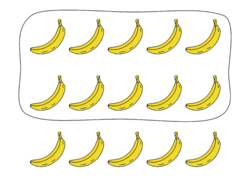
|
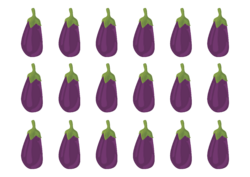
|
| 19 = _______ and _______ | 20 = _______ and _______ |
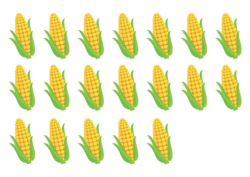
|
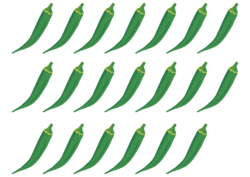
|
| 13 = _______ and _______ | 11 = _______ and _______ |
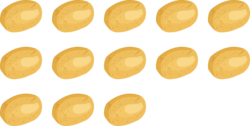
|

|
| 12 = _______ and _______ | 14 = _______ and _______ |

|
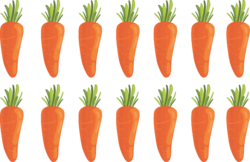
|
Write each number identifying the number of groups of 10s
| 34 has 30 and 4 | 78 has 70 and 8 | 91 has ______ and ______ |
| 47 has ______ and ______ | 71 has ______ and ______ | 40 has ______ and ______ |
| 63 has ______ and ______ | 98 has ______ and ______ | 39 has ______ and ______ |
| 76 has ______ and ______ | 81 has ______ and ______ | 53 has ______ and ______ |
| 33 has ______ and ______ | 41 has ______ and ______ | 59 has ______ and ______ |
| Write the missing number | ||
| 99 has 90 and 9 | 36 has 30 and 6 | 85 has ______ and 5 |
| 66 has 60 and ______ | ______ has 20 and 8 | 43 has ______ and 3 |
| ______ has 20 and 4 | 67 has 60 and ______ | ______ has 80 and 8 |
Activity: Identifying and writing expanded forms
Number Exercise: Writing expanded forms (75 to 120)
Activity: Count forward and backward (1s, 2s, 3s, 5s)
Number Exercise: Count forward and backward 50 to 99 (by 1s, 2s, and 3s).
Count forward by 1 and colour that flower yellow. Count backward by 2 and colour that flower red. Write all the numbers in the circles given below.
Count by 5 and colour that box red. Count by 10 and colour that box yellow.
| 5 | 10 | 15 | 20 | 25 | 30 | 35 | 40 | 45 | 50 |
| 23 | 28 | 33 | 38 | 43 | 48 | 53 | 58 | 63 | 68 |
| 36 | 41 | 46 | 51 | 56 | 61 | 66 | 71 | 76 | 81 |
| 17 | 22 | 27 | 32 | 37 | 42 | 47 | 52 | 57 | 62 |
Count by 3 and circle the numbers starting from 1. Join the circled numbers. Colour the picture yellow.
Activity: How many of a Total
Number Exercise: Knowing how many in a total number.
Color as many things to match the number given in the box and write the total number on the line given below.
Cardinal and Ordinal Numbers
A cardinal number defines how many (number) of something are present. Example, my friend's house is 4 (four) houses away from my house.
An ordinal number defines where (position) is something located in a list. Example, my friend’s house is the fourth building from my house.
So, if we say there are five persons standing in the line in a bank and the fifth person is wearing a blue shirt, we are
- counting the number of persons, seen standing in a line
- identifying the position of a particular person
Activity: My Train Ride
Number Exercise: Using the cardinal word forms and Ordinal numbers.
During the summer holidays, I went to Manguluru from Bengaluru by a train. The engine is the ___________ (1) and the foremost carriage of the train. My mother told me that a train also has cars in which we all travelled. The engine of our train was very strong. It pulled our long train having _________(18) cars easily even in uphill places. Our car was in the middle, _________ (9) from the engine. I sat by the window and was counting the trains and the number of cars they had. The ______(3) train that sped by us was very long having _________ (22) cars. I was surprised to see that the _________ (6) car of a train standing in a station had the words “Medical Van” written on it. It started to move when the guard waved a green flag standing on the _______ (7) car which was also the train’s last car.
It was fun walking along with my father in a moving train crossing __________ (5) cars to reach the __________ (4) car. It was the food or the pantry car. As the train took a bend in the hills, I saw that the ladies’ car was just _________ (2) cars away from the engine. Our car was followed by three air-conditioned cars which were in __________ (10), ___________ (11) and ____________ (12) places away from the engine. When I got off the train at Manguluru, as I walked towards the station, I saw the railway porters unloading many things from two cars in the rear. They were the ___________ (16) and _________ (17) cars. It was a joyous train ride and I was looking forward to visit my grandparents.
Activity: Pick a sweet mango
Number Exercise – Sorting, Ordinal numbers till 50, Making a number chart
Lakshmi likes sweet mangoes. So, her mother went to the wholesale market to buy mangoes for her to distribute to her friends on her birthday. She knew that ripe mangoes are yellow in color and they are sweet. Lakshmi’s mother wanted to make some mango pickle so she chose unripe mangoes from the carts. From the top row tell the number and position of the ripe and unripe mangoes.
| Ripe Mangoes | Unripe mangoes | ||
|---|---|---|---|
| Cardinal | Ordinal | Cardinal | Ordinal |
Odd and Even Numbers
Let’s talk about sharing now. Rama visited an orange farm when he went to his grandparents’ home. He brought 15 oranges home. And he wondered what he would do with so many oranges…
So, he decided to share them with his friends. He wanted to give the same number of oranges to both his friends.
Don’t we all share with whom we care for.
If Rama equally shared the oranges he had into two baskets...
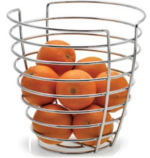
|

|
| Count and write how many oranges are in the basket _________. | Count and write how many oranges are in the basket _________. |
Rama split _____________ out of 15 oranges into two baskets of each and had __________ remaining with him which could not be shared with both his friends. He wondered why he could not share 15 oranges completely. However, he happily shared the rest and ate the one orange himself.
Then he gave the two baskets to his friends and asked his teacher about his activity. The teacher called all the class students. He asked each student what things they had more in number that could be shared with others.
Latha replied that they grew vegetables in their backyard and had grown many brinjal plants.
She had _______________ brinjals. The teacher then asked her to place one brinjal each into two heaps. She placed the brinjals in the following manner.
| Count and write how many brinjals are present _________. | Count and write how many brinjals are present _________. |
She did not have anything left after making two equal groups of brinjals.
The teacher informed that, any
Number ending in 0 2 4 6 8 are called Even
Number ending in 1 3 5 7 9 are called Odd
Rama had 15 oranges, having _________ as an ending number. So, 15 is an ___________ number. After splitting them in to two baskets he had ________ remaining. Rama understood that he had an odd number of oranges.
Latha had 18 oranges having __________ as an ending number. So, 18 is an ___________ number. After splitting them in to two heaps she had _____ with her. Latha came to know that she had an even number of brinjals. Latha gave one heap of brinjals to her neighbour and took one home happily.
Any number that can be split into two equal quantities without any leftover is Even.
Any number that leaves behind something after being split into two sets of equal quantities is Odd.
Activity: Identifying even and odd numbers
Number Exercise – Visual identification of odd and even numbers (0 to 50)
Identify looking at the number and write if it is even or odd, strike out as you write. Place only even numbers in one box and odd into another box.
| Write Even Numbers
18 | |
| Write Odd Numbers
25 |
Activity: Bees and Butterflies
Number Exercise: Counting by 2 for even and odd numbers.
Draw a line to lead the butterfly forwards by two flowers. Write the number and colour that flower yellow. Draw a line to lead the bee backwards by two flowers. Write the number and colour that flower orange.
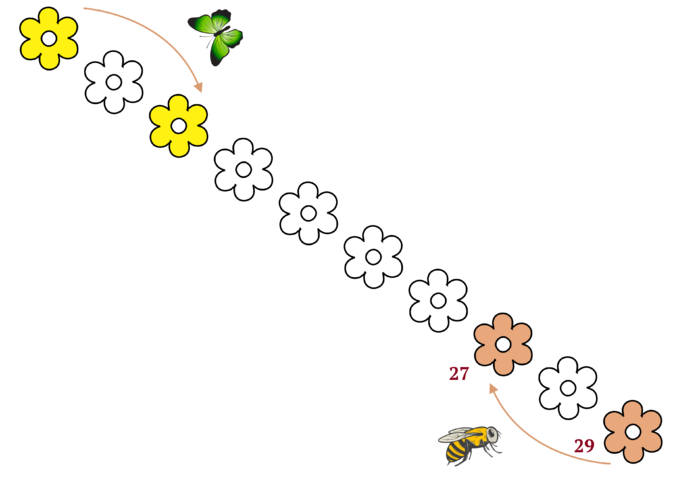
Comparing Numbers
We saw that Rama had 15 oranges and that he wanted to share them such that both his friends get same number of oranges.
| Friend 1 | Sign | Friend 2 | |
| Number of Oranges | 7 | 7 | |
| Equality Sign | 7 | 7 |
What is neither more not less is said to be equal in mathematical terms. It is said to be same. It is represented by the equal symbol =
It requires that two things are measured or compared before saying that they are “more” or “less” or “equal”. In mathematics, they are represented as shown below
Comparison can be between anything same or different. In our example we saw that Rama and Latha had different things namely, oranges and brinjals being compared for their number. We can compare many things for their sameness or differentness.
Activity: Comparison of two 2-digit numbers
Number Exercise: Comparing the quantity
Write the comparison sign between two numbers. Remember the following
| Greater than | Less than | Equal to |

| ||
| Number | Write the sign | Number | Number | Write the sign | Number |
| 28 | 39 | 45 | 8 | ||
| 14 | 14 | 19 | 16 | ||
| 74 | 100 | 62 | 62 | ||
| 10 | 99 | 53 | 86 | ||
| 0 | 5 | 33 | 35 | ||
| 25 | 0 | 91 | 91 | ||
| 76 | 89 | 69 | 59 | ||
| 22 | 7 | 44 | 22 |
Find the missing numbers. An example is given in each section of the table.
| Number | Numbers in between | Number |
|---|---|---|
| 43 | 44 45 | 46 |
| 108 | 112 | |
| 87 | 91 | |
| 20 21 22 | ||
| 53 54 | ||
| 1 2 3 | ||
| 99 100 101 |
| 2 Less | Number | 2 More | 5 Less | Number | 5 More |
|---|---|---|---|---|---|
| 27 | 29 | 31 | 80 | 85 | 90 |
| 78 | 120 | ||||
| 103 | 105 | ||||
| 46 | 70 | ||||
| 55 | 114 | ||||
| 117 | 97 |
Number-line
We can write whole numbers (and other kinds of numbers) on a horizontal straight line with numbers placed at equal intervals along its length infinitely extending on both sides. The numbers increase as we move from left to right and decrease as we move towards the right side. A number line can be made with numbers with a pattern, for example, a series of numbers differing by 3 can be written on the number line. It helps us compare numbers visually.
We can see that the numbers are increasing by 1 as we go along the number line.
Activity: Krishna Leela
Number Exercise: Introduction to number-line. Use a number line (visual of skip counting by 3) to mark the events.
A. Krishna was taken to Nanda's house in Gokula as soon as he was born. (represented as red dot on the number line)
B. When he was less than a month old, Putana the rakshasi, tried to poison him. (represented as red dot on the number line)
C. About the time of his first birthday, Krishna was carried up by Trinavarta, an other rakshasa.
D. Krishna was about five years old when he released Nalakubara and Manigriva from a curse.
E. He was seven years old when he lifted the Govardhana mountain to protect the people of Brindavan from the wrath of Indra.
F. At nine years of age Krishna danced on the hood of Kaliya, the snake.
G. At the age of eleven he killed Kamsa and had the upanayana samskara.
H. By the age of twenty, he destroyed Jarasandha's army and Kalayavana asura.
I. Krishna brought back the Syamantaka mani and married Satyabhama at the age of thirty years.
On the number line place a red point noting each age of Krishna's activities and answer the questions given below. Note that 0, 3 up to 30 (skip count by 3) are given on the number line.
- How many events took place before the age of 5? _________________
- How many events took place between the age of 10 and 20 years? _________________
- How many events took place between the age of 20 and 30 years? _________________
Word Numerals - Ancient Indian System of Representing Numbers
Till now we have seen that numbers have
- written symbols called as Anka
- arrangement method which is called as Decimal Place system
- value of numbers
- position
Now, in the early centuries in India, as mathematical system was evolving, our scholars developed a method of expressing numbers as words. They came up with Sankhya samjna (सङ्ख्यासंज्ञा), as mentioned in Ganitasaarasangraha[1] or "word numerals". They arranged them just as we see in the place-value notation.
These word numerals are expressed by names of things, beings or concepts, naturally or in accordance with the terms in Shastras. Thus, the number “one” is expressed by anything that is markedly unique such as the moon, earth etc and zero is expressed by words meaning sky, empty, complete etc. This system of representing numbers using words is called Bhutasankhya system. The word “Bhutasankhya” is a compound word. It is made up of the words bhuta and sankhya.
- Bhuta means ‘a being’
- Samkhya means ‘a number’
In the Bhutasankhya system, numbers are represented using common words such as:
- The physical bodies such as earth, moon (1), planets (9), stars, oceans, mountain, fire, sky, directions etc.
- The parts of a human body such as eyes, ears (2), jaws, knees, hands, fingers, teeth etc.
- The animals such as serpents, horse, elephants etc.
- The names of the devatas, such as Shiva, Indra, Surya and sometimes historical persons such as Manu, Rama (3) etc.


Thus, the Bhutasamkhya refers to the collection of set of ‘things’ denoted by that number. Our ancient mathematicians used these terms in their shlokas to mention the number they had in mind. Some numbers have multiple representations, such as
- Four 4 – Brahma (Chaturmukha) and Vedas (Chaturveda)
- 2 – Eyes, Ears, Twins, Shoulders
- 3 –
- 6 –
- 8 –
- 9 –
Bhutasankhya System of representing number
Activity: Representation of numbers using words
Number Exercise: Identify the number given in the Bhutasankhya (word numerals)
| Bhutasankhya | Circle one number to indicate the Bhutasankhya | |||
| Puranas | 23 | 45 | 18 | 89 |
| Masas (months) | 33 | 12 | 10 | 64 |
| Bhuvanas (worlds) | 10 | 4 | 14 | 33 |
| Rishis | 7 | 34 | 17 | 54 |
| Kalas (arts) | 46 | 39 | 14 | 64 |
| Vasus (a kind of devatas) | 18 | 44 | 8 | 20 |
| Vidyas | 10 | 14 | 56 | 72 |
| Bhutas (beings) | 15 | 24 | 5 | 99 |
| Ratnas (gems) | 19 | 9 | 49 | 66 |
| Adityas | 12 | 34 | 22 | 10 |
| Manus (a ruler of earth) | 14 | 52 | 100 | 74 |
| Chandra Kalas (moon’s phases) | 10 | 26 | 56 | 16 |
| Number of Devatas | 33 | 66 | 49 | 30 |
| Adri or Achala (mountains) | 10 | 7 | 14 | 64 |
| Bhujas (shoulders) | 90 | 2 | 100 | 53 |
| Danta (teeth) | 10 | 24 | 32 | 30 |
| Visvedevas (a kind of devatas) | 13 | 16 | 39 | 22 |
| Saagara (oceans) | 10 | 37 | 4 | 7 |
Match the following
|
|
Activities and Exercises
- Make a board or draw on ground numbers 1 to 30 in squares. The teacher calls out an odd and even number which should be located on the ground by the children for that many rubberbands.
- Every child collects 109 number of items like toothpicks, match sticks, icecream spoons (long and short wooden), small spent pencils etc. Every child must make bundles of 10 of these using rubberbands. After making 10 bundles 9 will be kept loose. Show your number work using these bundles. 4 bundles and 3 loose toothpicks make 43 .... and so... on.
- Make your own clock using the Bhutasankhya numbers you learnt.
Find the even or odd numbers between the two numbers given
| Number | Even numbers | Number | Number | Odd number | Number |
|---|---|---|---|---|---|
| 47 | 48 | 50 | 18 | 19 21 | 23 |
| 11 | 12 14 | 15 | 37 | 42 | |
| 13 | 19 | 23 | 29 | ||
| 31 | 36 | 25 | 31 | ||
| 17 | 22 | 42 | 48 | ||
| 39 | 45 | 11 | 14 | ||
| 29 | 33 | 32 | 36 |
Identify and write the Bhutasankhya between two numbers given below
| Number | Bhutasankhya | Number |
|---|---|---|
| 9 | Dashanana or Ravana | 11 |
| 31 | 33 | |
| 63 | 65 | |
| 26 | 28 |
Compare the numbers and write less than or more than or equal to symbols.
| Bhutasankhya | Write the symbols | Bhutasankhya |
|---|---|---|
| Chandra | Shiva | |
| Kalas (Arts) | Dantas | |
| Giri (mountains) | Svaras (music) | |
| Kartikeya | Vedas | |
| Rishis | Sagaras | |
| Vidyas | Puranas | |
| Aditya | Masas |
Practice writing numbers in Samskrit and English
Cardinal and Ordinal Number Chart (1 to 50)
See and learn to write numbers in Samskrit. Fill the charts with numbers in English (cardinal and ordinal)
| Numbers | Word Forms | Position | Numbers | Word Forms | Position |
|---|---|---|---|---|---|
| १ | एकम् | प्रथम | 26 | ||
| २ | द्वे | द्वितीय | |||
| ३ | त्रीणि | तृतीय | |||
| ४ | चत्वारि | चतुर्थ | |||
| ५ | पञ्च | पञ्चम | |||
| ६ | षट् | षष्ट | |||
| ७ | सप्त | सप्तम | |||
| ८ | अष्ट | अष्टम | |||
| ९ | नव | नवम | |||
| १० | दश | दशम | |||
| ११ | एकादश | एकादशतम | |||
| १२ | द्वादश | द्वादशतम | |||
| १३ | त्रयोदश | त्रयोदशतम | |||
| १४ | चतुर्दश | चतुर्दशतम | |||
| १५ | पञ्चदश | पञ्चदशतम | |||
| १६ | षोडश | षोडशतम | |||
| १७ | सप्तदश | सप्तदशतम | |||
| १८ | अष्टादश | अष्टादशतम | |||
| १९ | नवदश | नवदशतम | |||
| २० | विंशतिः | विंशतितम | |||
| २१ | एकविंशतिः | एकविंशतितम | |||
| २२ | द्वाविंशतिः | द्वाविंशतितम | |||
| २३ | त्रयोविंशतिः | त्रयोविंशतितम | |||
| २४ | चतुर्विंशतिः | चतुर्विंशतितम | |||
| २५ | पञ्चविंशतिः | पञ्चविंशतितम | 50 |
Cardinal and Ordinal Number Chart (51 to 70)
| Numbers | Word Forms | Position |
| 51 | ||
Practice writing numbers in Samskrit

|

|
||||

|

|
||||

|

|
||||

|

|
||||
References
- ↑ Rangacharya, M. (1912) Ganita-Sara-Sangraha of Mahaviracharya with English translation and notes. Madras: Government Press (Pages 6 and 7 from अथ सङ्ख्यासंज्ञा Shloka 53 to 62)

